| THOROUGHFARE | ||
| Trafalgar Square | ||
|---|---|---|
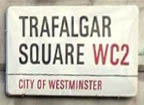
| ||
| Borough | Westminster | |
| District | Charing Cross | |
| Length | ||
| Number Range | ||
| Type | Monumental and Historical | |
| Post Code | WC2 | |
| Adjacent Streets | ||
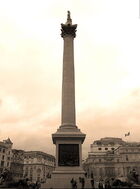
North view of Trafalgar Square.

One of the four lions guarding Nelson's Column.
Trafalgar Square is a square in Charing Cross, London. Having a position as the heart of London, it is a tourist attraction; its trademark is Nelson's Column which stands in the centre and the four lion statues that guard the column. Statues and sculptures are on display in the square, including a fourth plinth displaying changing pieces of contemporary art, and it is a site of political demonstrations.
The name commemorates the Battle of Trafalgar (1805), a British naval victory of the Napoleonic Wars. The original name was to have been "King William the Fourth's Square", but George Ledwell Taylor suggested the name "Trafalgar Square".
The northern area of the square had been the site of the King's Mews since the time of Edward I, while the southern end was the original Charing Cross, where the Strand from the City met Whitehall, coming north from Westminster. As the midpoint between these twin cities, Charing Cross is to this day considered the heart of London, from which all distances are measured.
In the 1820s the Prince Regent engaged the landscape architect John Nash to redevelop the area. Nash cleared the square as part of his Charing Cross Improvement Scheme. The present architecture of the square is due to Sir Charles Barry and was completed in 1845.
Overview[]
The square consists of a large central area surrounded by roadways on three sides, and stairs leading to the National Gallery on the other. The roads which cross the square form part of the A4 road, and prior to 2003, the square was surrounded by a one-way traffic system. Underpasses attached to Charing Cross tube station allow pedestrians to avoid traffic. Recent works have reduced the width of the roads and closed the northern side of the square to traffic.
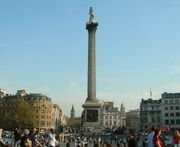
Trafalgar Square viewed from the north.
Nelson's Column is in the centre of the square, surrounded by fountains designed by Sir Edwin Lutyens in 1939 (replacing two earlier fountains of Peterhead granite, now at the Wascana Centre and Confederation Park in Canada) and four huge bronze lions sculpted by Sir Edwin Landseer; the metal used is said to have been recycled from the cannon of the French fleet. The column is topped by a statue of Horatio, Viscount Nelson, the admiral who commanded the British Fleet at Trafalgar.
The fountains are memorials to Lord Jellicoe (western side) and Lord Beatty (eastern side), Jellicoe being the Senior Officer.
On the north side of the square is the National Gallery and to its east St Martin-in-the-Fields church. The square adjoins The Mall via Admiralty Arch to the southwest. To the south is Whitehall, to the east Strand and South Africa House, to the north Charing Cross Road and on the west side Canada House.
At the corners of the square are four plinths; the two northern ones were intended for equestrian statues, and thus are wider than the two southern. Three of them hold statues: George IV (northeast, 1840s), Henry Havelock (southeast, 1861, by William Behnes), and Sir Charles James Napier (southwest, 1855). Mayor of London Ken Livingstone controversially expressed a desire to see the two generals replaced with statues "ordinary Londoners would know".
On the lawn in front of the National Gallery are two statues, James II to the west of the entrance portico and George Washington to the east. The latter statue, a gift from the state of Virginia, stands on soil imported from the United States. This was done in order to honour Washington's declaration he would never again set foot on British soil.
In 1888 the statue of General Charles George Gordon was erected. In 1943 the statue was removed and, in 1953, re-sited on the Victoria Embankment. A bust of the Second World War First Sea Lord Admiral Cunningham by Franta Belsky was unveiled in Trafalgar Square on 2 April 1967 by Prince Philip, Duke of Edinburgh.
The Square has become a social and political location for visitors and Londoners alike, developing over its history from "an esplanade peopled with figures of national heroes, into the country’s foremost place politique," as historian Rodney Mace has written. Its symbolic importance was demonstrated in 1940 when the Nazi SS developed secret plans to transfer Nelson's Column to Berlin following an expected German invasion, as related by Norman Longmate in If Britain Had Fallen (1972).
Fourth plinth[]
The fourth plinth on the northwest corner, designed by Sir Charles Barry and built in 1841, was intended to hold an equestrian statue of William IV, but remained empty due to insufficient funds. Later, agreement could not be reached over which monarch or military hero to place there.
In 1999, the Royal Society of Arts conceived the Fourth Plinth Project, which temporarily occupied the plinth with a succession of works commissioned from three contemporary artists. These were:
- Ecce Homo, by Mark Wallinger (1999)
- Regardless of History, by Bill Woodrow (2000)
- Monument, by Rachel Whiteread (2001)
Wallinger's Ecce Homo – the Latin title of which means "Behold the man", a reference to the words of Pontius Pilate at the trial of Jesus Christ (John 19:5) – was a life-sized figure of Christ, naked apart from a loin cloth, with his hands bound behind his back and wearing a crown of barbed wire (in allusion to the crown of thorns). Atop the huge plinth, designed for larger-than-life statuary, it looked minuscule. Some commentators said that, far from making the man look insignificant, his apparent tininess drew the eye powerfully; they interpreted it as a commentary on human delusions of grandeur.
Whiteread's Monument, by an artist already notable for her controversial Turner Prize-winning work House and the Judenplatz Holocaust Memorial in Vienna, was a cast of the plinth in transparent resin, and placed upside-down on top of the original. Following the exhibition project, some wished to see it continue in this role.
Various companies have used the plinth (often without permission) as a platform for publicity stunts, including a model of David Beckham by Madame Tussauds during the 2002 FIFA World Cup. The London-based American harmonica player Larry Adler jokingly suggested erecting a statue of Moby-Dick, which would then be called the "Plinth of Whales". A television ident for the British TV station Channel 4 shows a CGI Channel 4 logo on top of the fourth plinth.
The best use of the fourth plinth remains the subject of debate. On 24 March 2003 an appeal was launched by Wendy Woods, the widow of the anti-apartheid journalist Donald Woods, hoping to raise £400,000 to pay for a nine-foot high statue of Nelson Mandela by Ian Walters. The relevance of the location is that South Africa House, the South African high commission, scene of many anti-apartheid demonstrations, is on the East side of Trafalgar Square.
A committee convened to consider the RSA's late-1990s project concluded that it had been a success and "unanimously recommended that the plinth should continue to be used for an ongoing series of temporary works of art commissioned from leading national and international artists". After several years in which the plinth stood empty, the new Greater London Authority assumed responsibility for the fourth plinth and started its own series of changing exhibitions:
- Marc Quinn: Alison Lapper Pregnant (unveiled 15 September 2005) – a 3.6-m, 13-t marble torso-bust of Alison Lapper, an artist who was born with no arms and shortened legs due to a condition called phocomelia.
- Thomas Schütte: Model for a Hotel 2007 (formerly Hotel for the Birds) (unveiled 7 November 2007) – a 5-m by 4.5-m by 5-m architectural model of a 21-storey building made from coloured glass. The work cost £270,000 and was funded primarily by the Mayor of London and the Arts Council of England. Sandy Nairne, director of the National Portrait Gallery and chairman of the Fourth Plinth Commissioning Group that recommended Quinn's and Schütte's proposals to the Mayor in 2004, has said: "There will be something extraordinarily sensual about the play of light through the coloured glass. ... [I]t's going to feel like a sculpture of brilliance and light."
In February 2008, Terry Smith, the chief executive of trading house Tullett Prebon, offered to pay more than £100,000 for a permanent statue acceptable to "ordinary Londoners" of Air Chief Marshal Sir Keith Rodney Park in recognition of his work as commander of No. 11 Group RAF during the Battle of Britain, as it was this Group that was responsible for the defence of London. A Greater London Authority spokesman said: "There are many worthy suggestions for statues on the fourth plinth and some people feel passionately about each of them. All proposals will be judged on their merits including its current use as one of the most high profile sites for contemporary public art in London. The cost of erecting the current work on the plinth is £270,000. The cost of a permanent monument is likely to be considerably more."
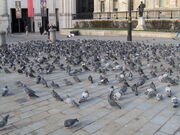
Pigeons flocking to London's Trafalgar Square, 2006. As at 2008 the pigeons have largely gone.
Pigeons[]
The square is a tourist spot in London, and used to be famous for its pigeons (Rock Pigeons). Feeding the pigeons was a popular activity with Londoners and tourists. The National Portrait Gallery displays a 1948 photograph of Elizabeth Taylor posing there with bird seed so as to be mobbed by birds. The desirability of the birds' presence has long been contentious: their droppings look ugly on buildings and damage the stonework, and the flock, estimated at its peak to be 35,000, was considered to be a health hazard. In 1996, police arrested one man who was estimated to have trapped 1,500 birds for sale to a middleman; it is assumed that the birds ended up in the human food chain.
In 2000, the sale of bird seed in the square was controversially terminated and other measures were introduced to discourage the pigeons, including the use of trained falcons. Supporters of the birds – including Save the Trafalgar Square Pigeons – as well as some tourists continued to feed the birds, but, in 2003, Ken Livingstone enacted byelaws to ban the feeding of pigeons within the square. On 10 September 2007 the byelaws were secured sealing an outright ban on feeding birds in area of the square. There are now few birds in Trafalgar Square and it is used for festivals and hired out to film companies, in a way that was not feasible in the 1990s.
Redevelopment[]
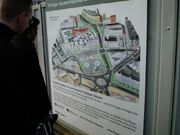
Members of the public read plans to pedestrianise part of the square, February 2003.
In 2003 the redevelopment of the north side of the square was completed. The work involved permanently closing the main eastbound road there - diverting it around the rest of the square and demolishing part of the wall and building a wide set of stairs. This construction includes two Saxon scissor lifts for disabled access, public toilets, and a small café. Plans for a large staircase had long been discussed, even in original plans for the square. The new stairs lead to a large terrace or piazza in front of the National Gallery, in what was previously a road. Previously access between the square and the Gallery was via two busy crossings at the north east and north west corners of the square. The pedestrianisation plan was carried out in the face of protests from both road-users and pedestrians concerned that the diversion of traffic would lead to greater congestion elsewhere in London. However, this does not seem to have happened; the reduction in traffic due to the London congestion charge may be a factor.
Christmas ceremony[]
There has been a Christmas ceremony every year since 1947. A Norway Spruce (or sometimes a fir) is given by Norway's capital Oslo and presented as London's Christmas tree, as a token of gratitude for Britain's support during World War II. (Besides the general war support, Norway's Prince Olav, as well as the country's government, lived in exile in London throughout the war.) As part of the tradition, the Lord Mayor of Westminster visits Oslo in the late autumn to take part in the felling of the tree, and the Mayor of Oslo then comes to London to light the tree at the Christmas ceremony.
Political demonstrations[]
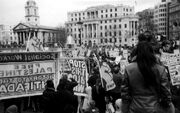
A demonstration in Trafalgar Square.
Since its construction, Trafalgar Square has been a venue for political demonstrations, though the authorities have often attempted to ban them. The 1939 fountains were allegedly added on their current scale to reduce the possibility of crowds gathering in the square as they were not in the original plans.
By March of the year Nelson's column opened, the authorities had started banning Chartist meetings in the square. A general ban on political rallies remained in effect until the 1880s, when the emerging Labour movement, particularly the Social Democratic Federation, began holding protests there.
On "Black Monday" (8 February 1886), protesters rallied against unemployment; this led to a riot in Pall Mall. A larger riot (called "Bloody Sunday") occurred in the square on 13 November 1887.
One of the first significant demonstrations of the modern era was held in the square on 19 September 1961 by the Committee of 100, which included the philosopher Bertrand Russell. The protesters rallied for peace and against war and nuclear weapons.
Throughout the 1980s, a continuous anti-apartheid protest was held outside of South Africa House. More recently, the square has hosted the Poll Tax Riots (1990) and anti-war demonstrations opposing the Afghanistan war and the Iraq war.
The Square was also scene to a large vigil held shortly after the terrorist bombings in London on Thursday 7 July 2005.
Sports events[]
On 21 June 2002, 12,000 people gathered in the square to watch the England national football team's World Cup quarter-final against Brazil on giant video screens which had been erected specially for the occasion.
In the early 21st century, Trafalgar Square has become the location to the climax for victory parades; firstly for the England national rugby union team to celebrate victory in the 2003 Rugby World Cup on December 9, 2003, and then on September 13, 2005, when the climax of the victory parade for the England national cricket team's victory against the Australia national cricket team in The Ashes took place there.
In 6 July 2005 Trafalgar Square was a gathering place for many London citizens to hear the announcement that they will host the 2012 Summer Olympics.
In 2007, Trafalgar Square hosted the opening ceremonies of the Tour de France.
VE Day celebrations[]
Victory in Europe Day (V-E Day or VE Day) was 8 May 1945, the date when the Allies during the Second World War formally celebrated the defeat of Nazi Germany and the end of Adolf Hitler's Third Reich.
Trafalgar Square was filled with British subjects wanting to hear the formal announcement by Sir Winston Churchill that the war was over. Trafalgar Square was used as a place of celebration and people from all over the country came there.
On Sunday 8 May 2005 the BBC held a concert to celebrate the 60th anniversary of VE Day which was hosted by Eamonn Holmes and Natasha Kaplinsky. Many people who lived during the war attended, and many of the much younger generation, but most importantly many old veterans came and told the stories of their hardships during the six years of war.
New Year events[]
For many years, revellers celebrating the start of a New Year have gathered on the square, despite a lack of civic celebrations being arranged for them. The lack of official events in the square was partly because the authorities were concerned that actively encouraging more partygoers would cause overcrowding.
Hogmanay at Edinburgh, Scotland has instead been the focus for British New Year celebrations, although since 2005, a firework display centred on London Eye and the South Bank of the Thames, near the square, has given spectators a fitting start to the New Year.
Access[]
Nearest London Underground stations:
- Charing Cross- Northern and Bakerloo Lines) — has an exit in the square. The two lines originally had separate stations, of which the Bakerloo Line one was called Trafalgar Square; they were linked and renamed in 1979 as part of the construction of the Jubilee Line, which was later rerouted elsewhere.
- Embankment- District, Circle, Northern and Bakerloo Lines.
- Leicester Square- Northern and Piccadilly lines)
Bus routes running through Trafalgar Square: 6, 9, 11, 12, 13, 15, 23, 24, 29, 53, 87, 88, 91, 139, 159, 176, 453
| This page uses Creative Commons Licensed content from Wikipedia (view authors). That Wikipedia page probably contains more information. |